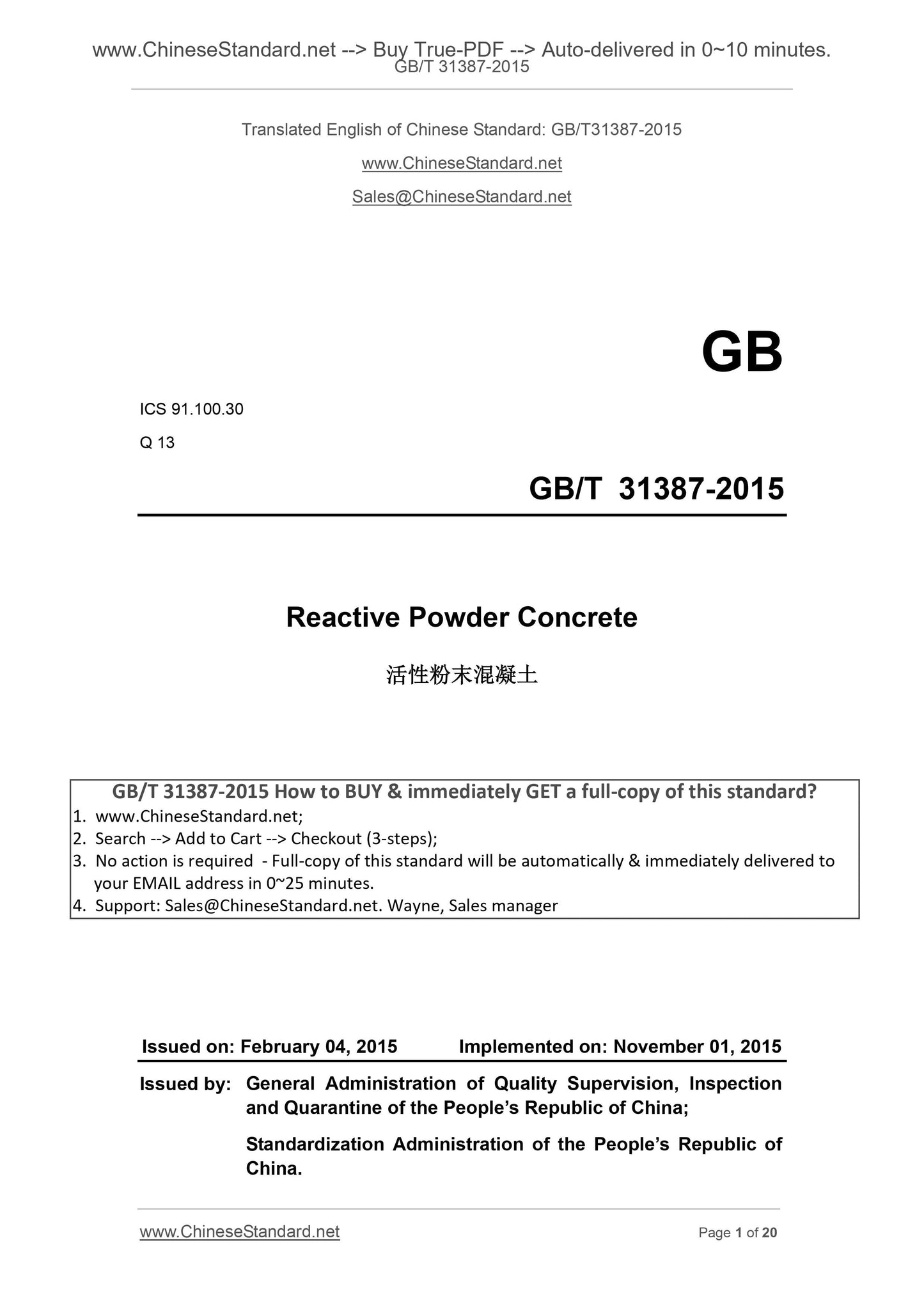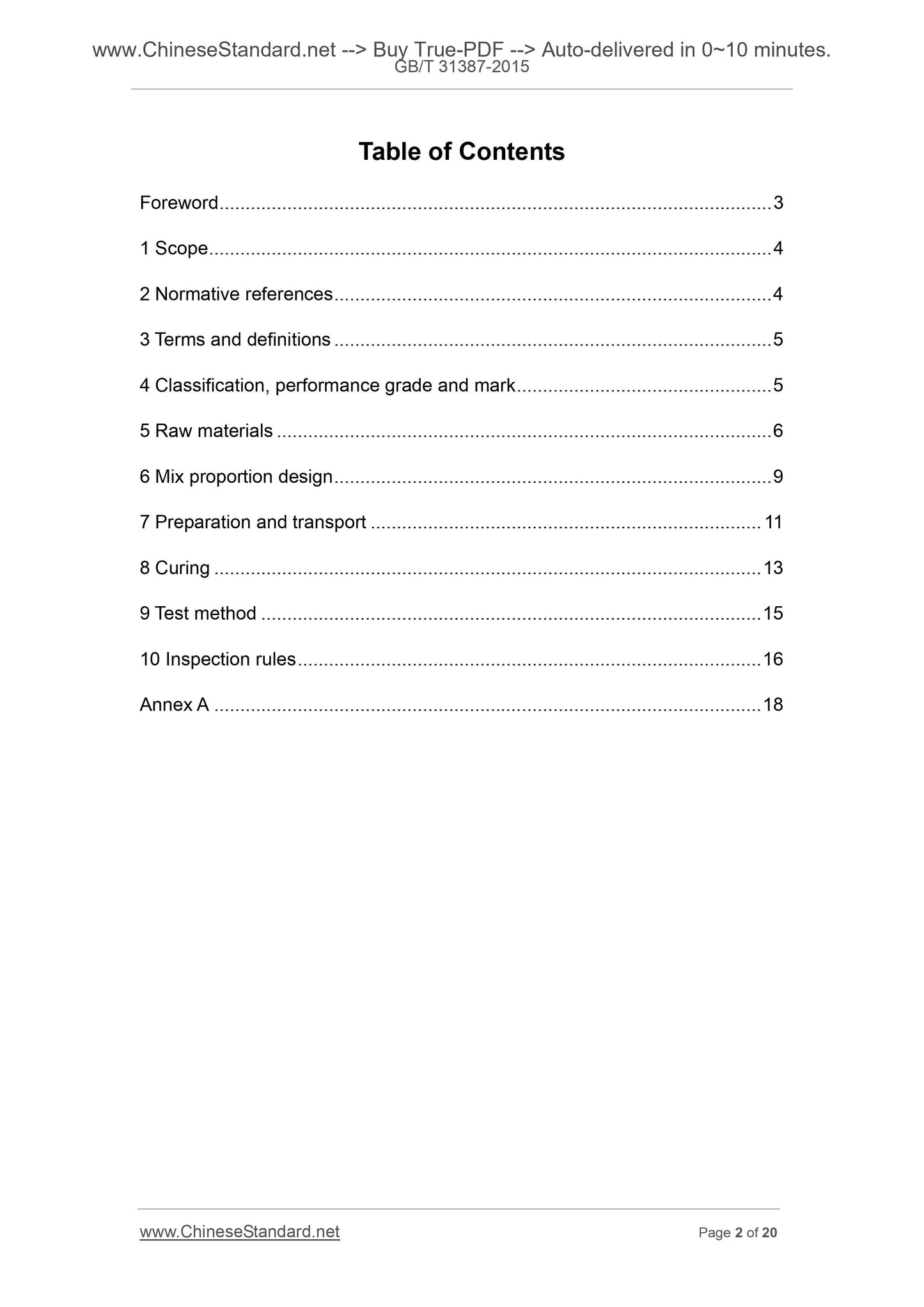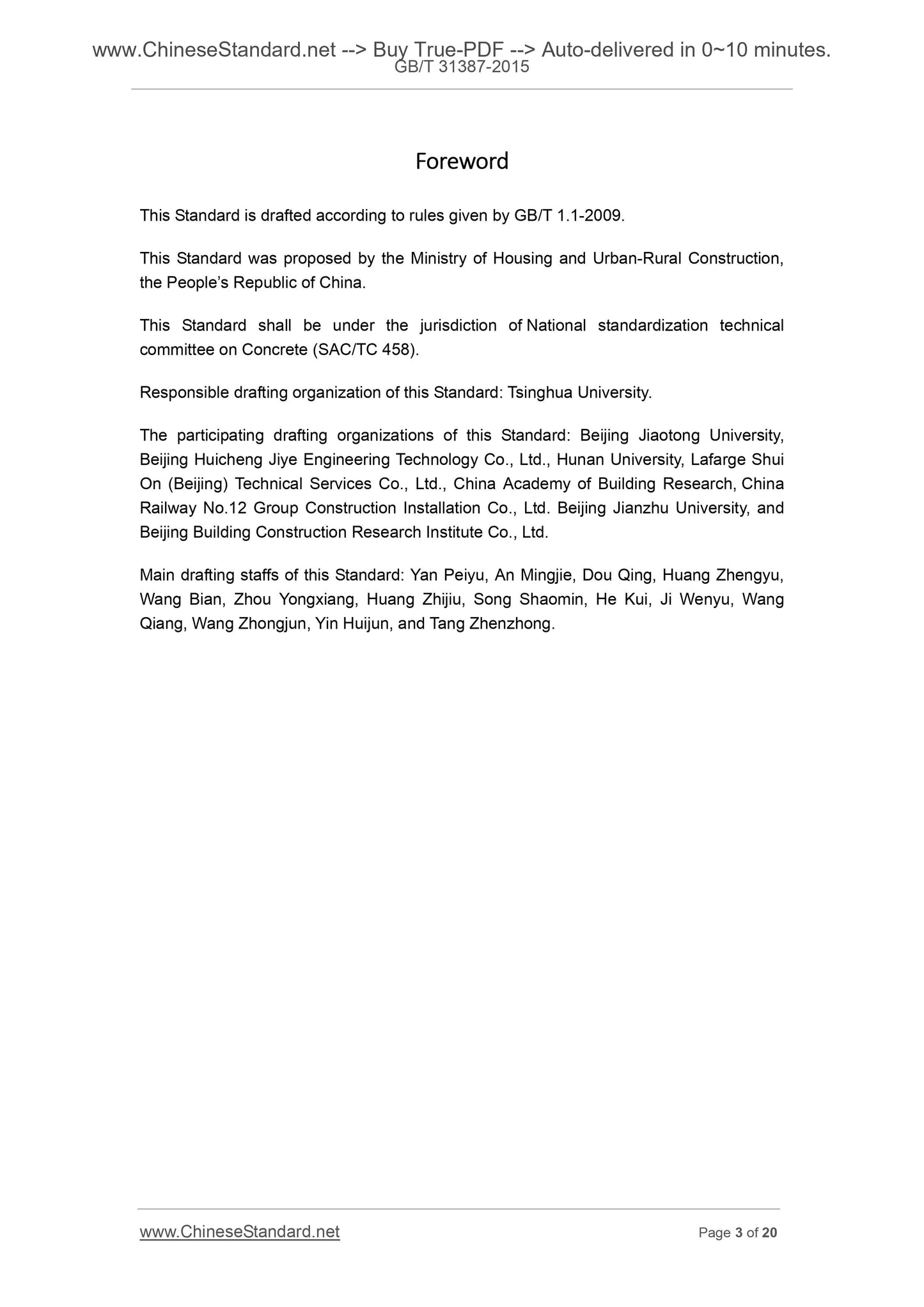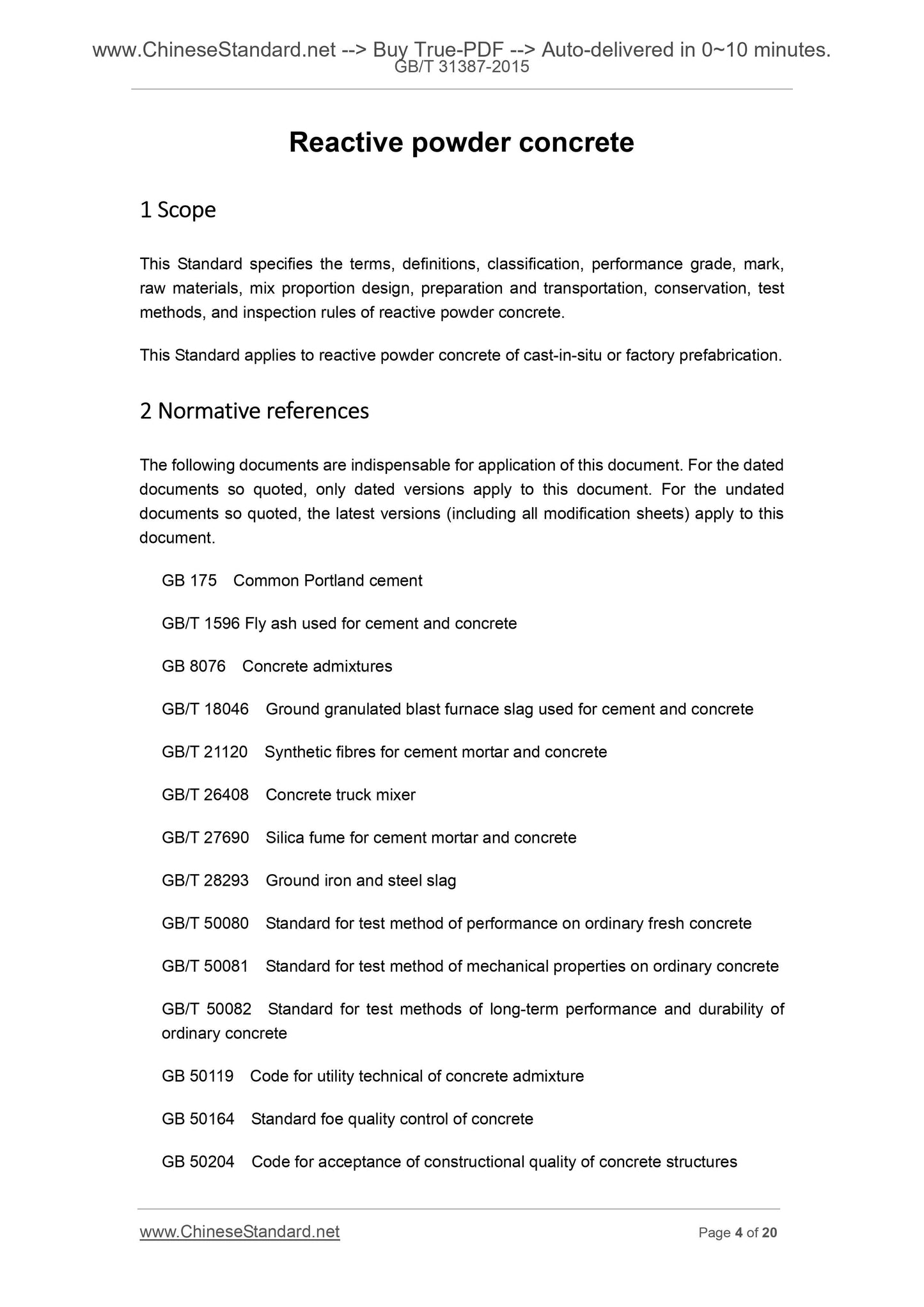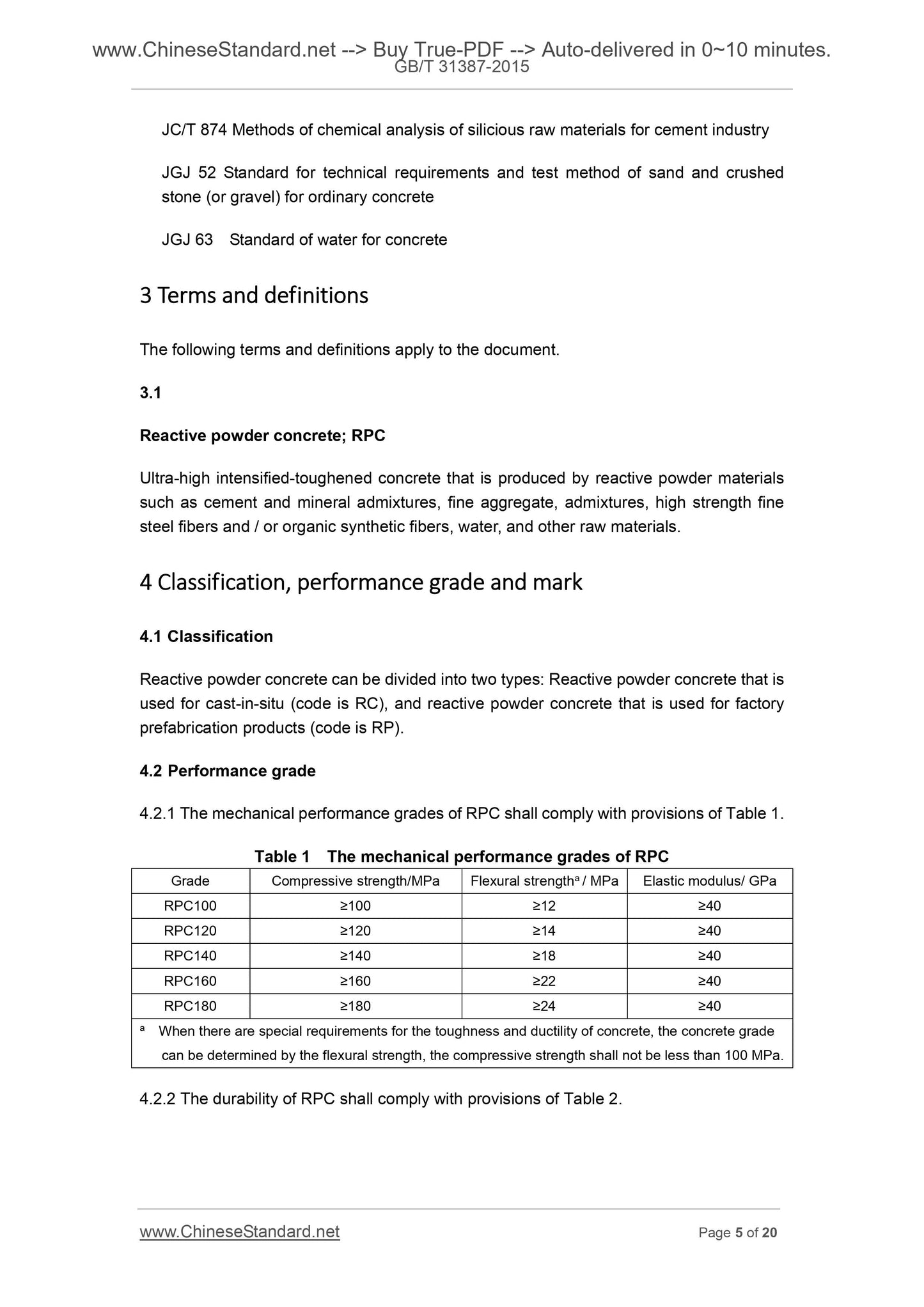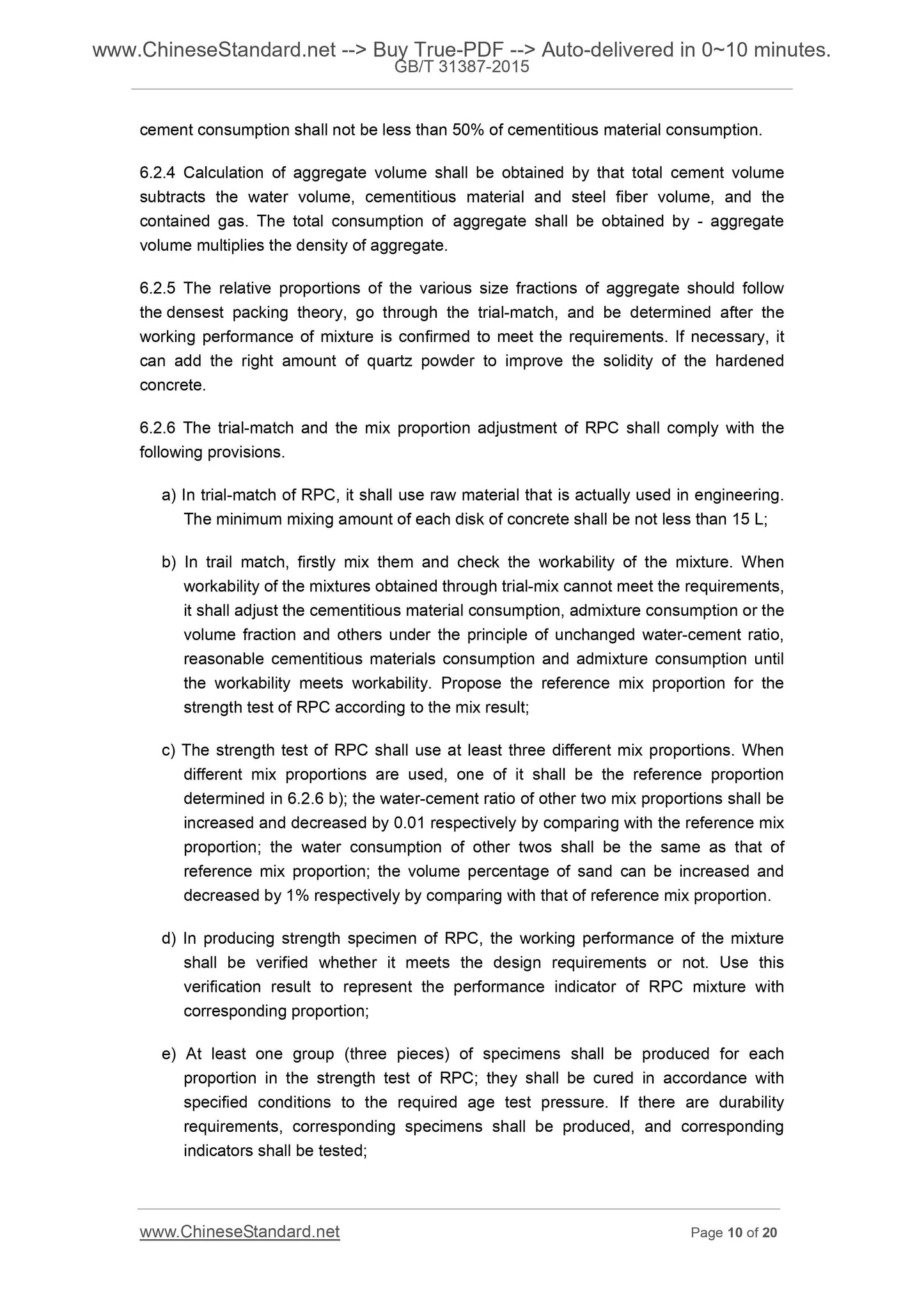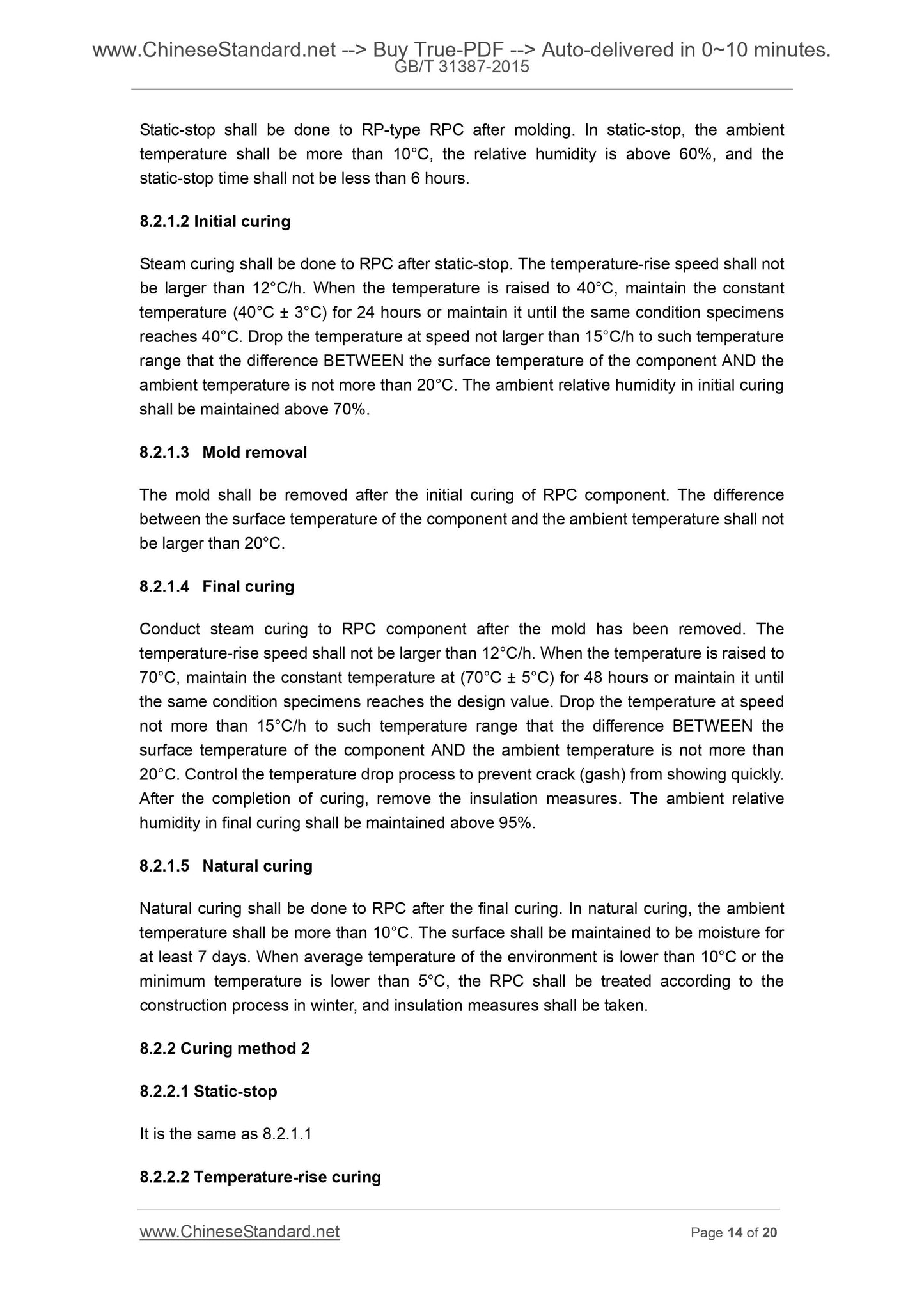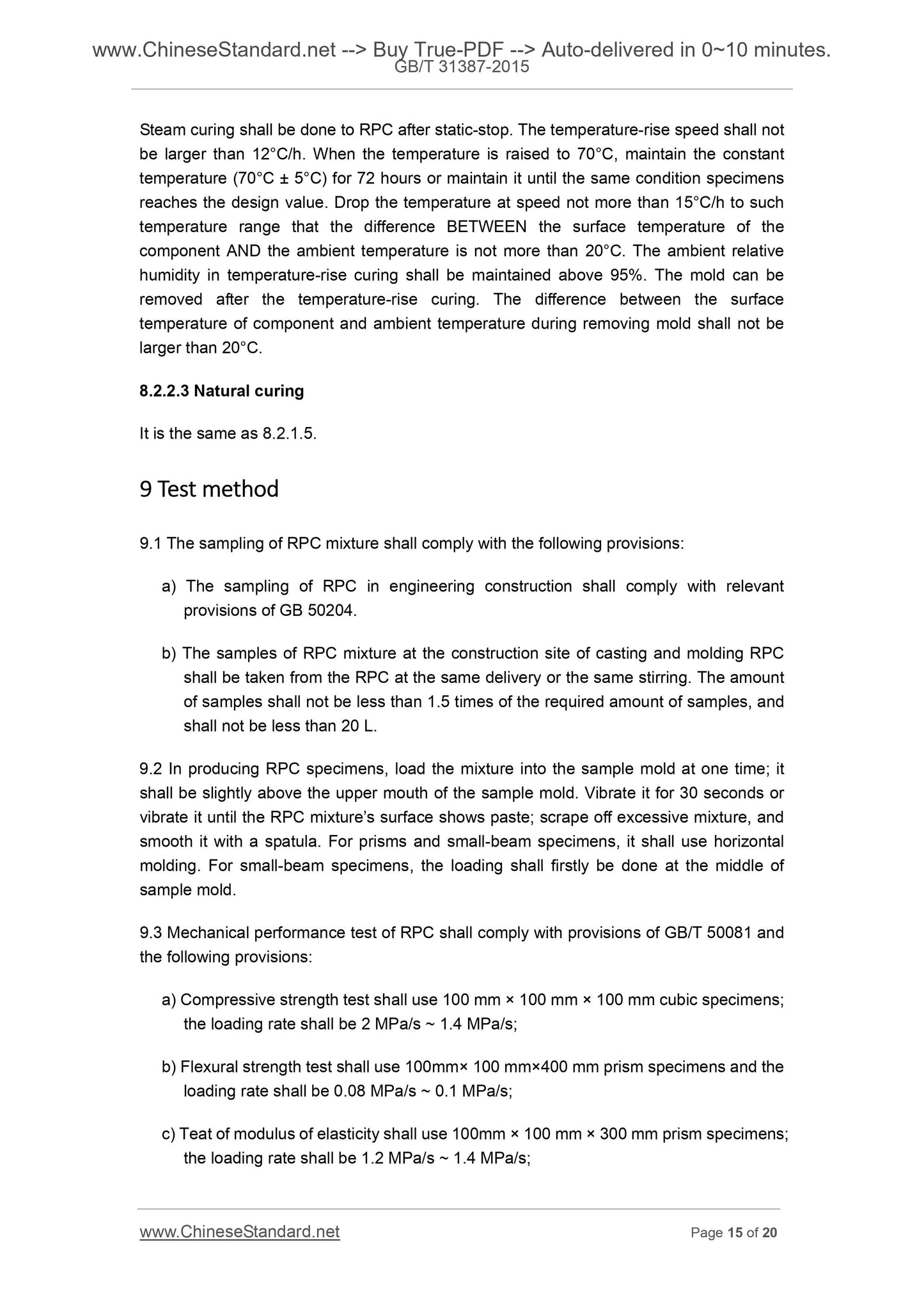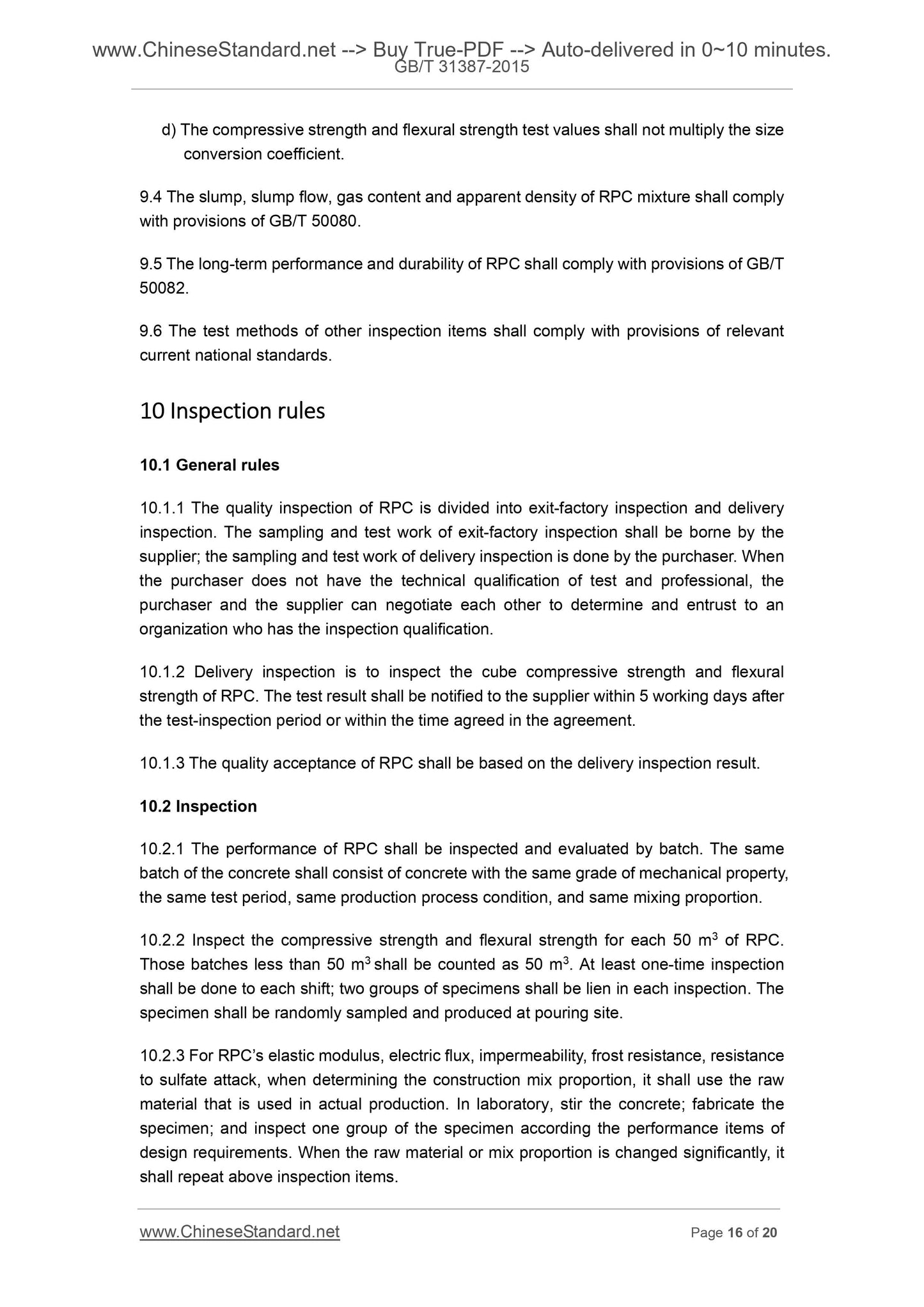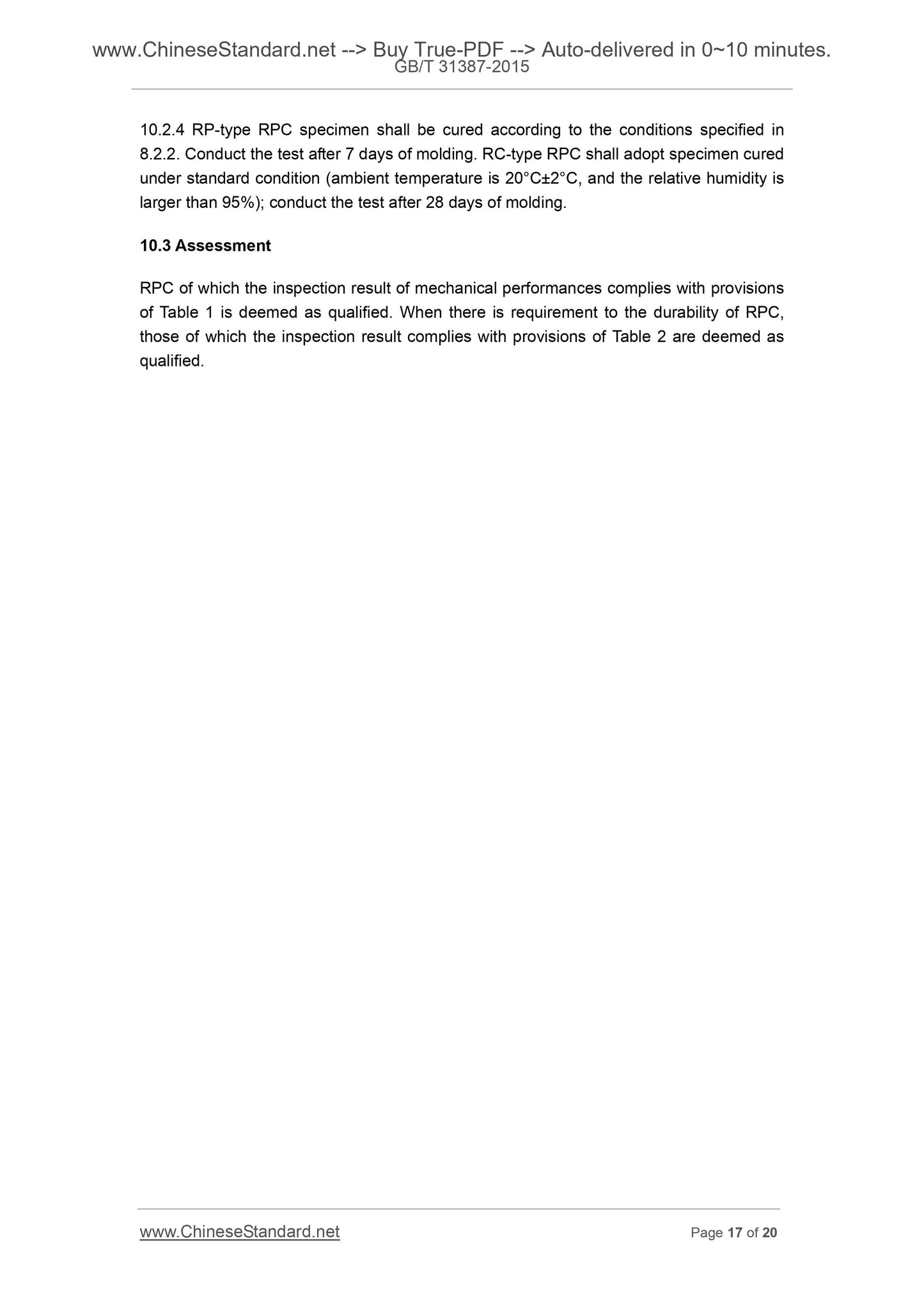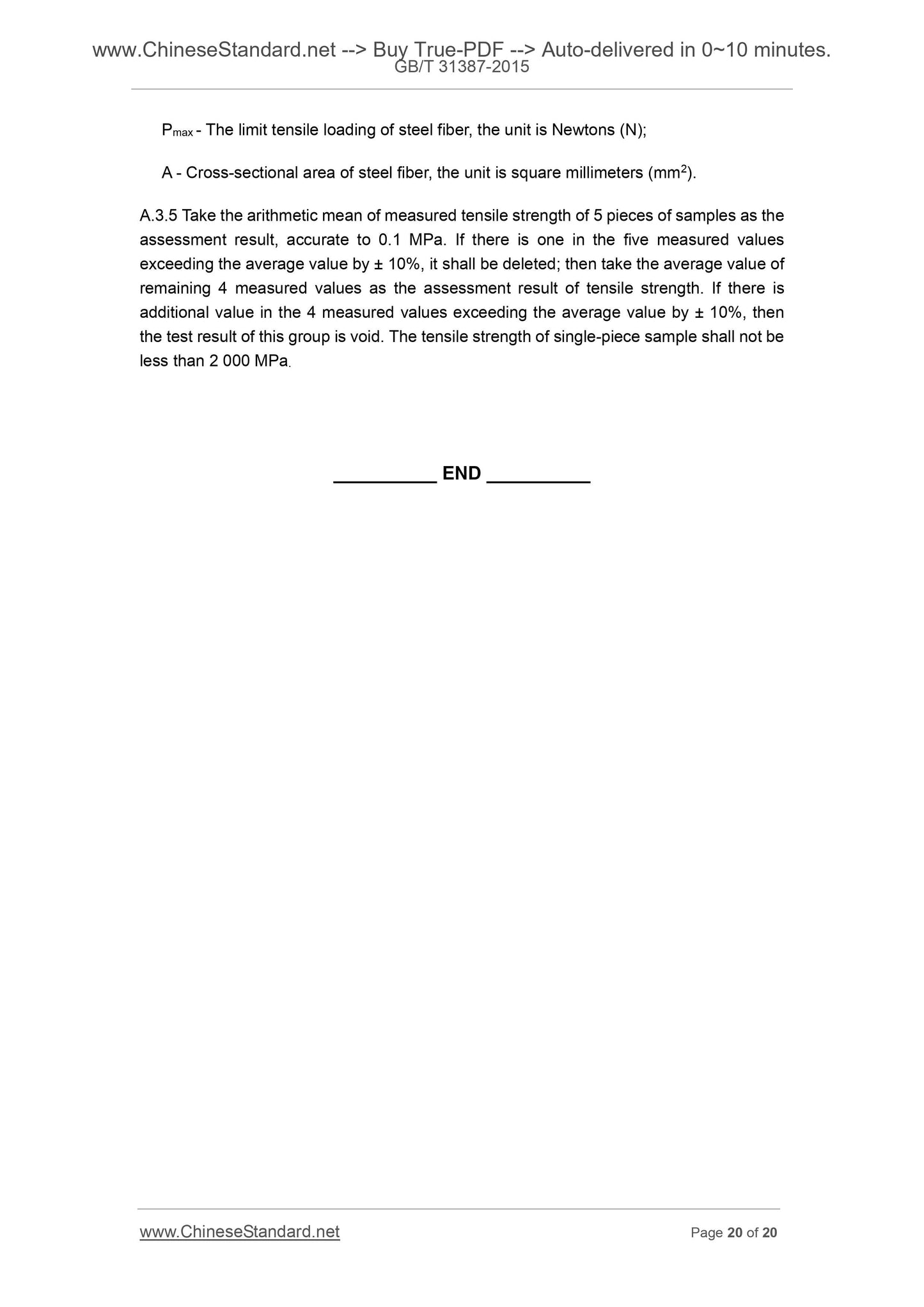1
/
of
11
PayPal, credit cards. Download editable-PDF and invoice in 1 second!
GB/T 31387-2015 English PDF (GBT31387-2015)
GB/T 31387-2015 English PDF (GBT31387-2015)
Regular price
$130.00 USD
Regular price
Sale price
$130.00 USD
Unit price
/
per
Shipping calculated at checkout.
Couldn't load pickup availability
Delivery: 3 seconds. Download true-PDF + Invoice.
Get QUOTATION in 1-minute: Click GB/T 31387-2015
Historical versions: GB/T 31387-2015
Preview True-PDF (Reload/Scroll if blank)
GB/T 31387-2015: Reactive powder concrete
GB/T 31387-2015
GB
ICS 91.100.30
Q 13
Reactive Powder Concrete
活性粉末混凝土
ISSUED ON. FEBRUARY 04, 2015
IMPLEMENTED ON. NOVEMBER 01, 2015
Issued by.
General Administration of Quality Supervision, Inspection
and Quarantine of the People’s Republic of China;
Standardization Administration of the People’s Republic of
China.
Table of Contents
Foreword ... 3
1 Scope ... 4
2 Normative references ... 4
3 Terms and definitions ... 5
4 Classification, performance grade and mark ... 5
5 Raw materials ... 6
6 Mix proportion design ... 9
7 Preparation and transport ... 11
8 Curing ... 13
9 Test method ... 15
10 Inspection rules ... 16
Annex A ... 18
Foreword
This Standard is drafted according to rules given by GB/T 1.1-2009.
This Standard was proposed by the Ministry of Housing and Urban-Rural Construction,
the People’s Republic of China.
This Standard shall be under the jurisdiction of National standardization technical
committee on Concrete (SAC/TC 458).
Responsible drafting organization of this Standard. Tsinghua University.
The participating drafting organizations of this Standard. Beijing Jiaotong University,
Beijing Huicheng Jiye Engineering Technology Co., Ltd., Hunan University, Lafarge Shui
On (Beijing) Technical Services Co., Ltd., China Academy of Building Research, China
Railway No.12 Group Construction Installation Co., Ltd. Beijing Jianzhu University, and
Beijing Building Construction Research Institute Co., Ltd.
Main drafting staffs of this Standard. Yan Peiyu, An Mingjie, Dou Qing, Huang Zhengyu,
Wang Bian, Zhou Yongxiang, Huang Zhijiu, Song Shaomin, He Kui, Ji Wenyu, Wang
Qiang, Wang Zhongjun, Yin Huijun, and Tang Zhenzhong.
Reactive powder concrete
1 Scope
This Standard specifies the terms, definitions, classification, performance grade, mark,
raw materials, mix proportion design, preparation and transportation, conservation, test
methods, and inspection rules of reactive powder concrete.
This Standard applies to reactive powder concrete of cast-in-situ or factory prefabrication.
2 Normative references
The following documents are indispensable for application of this document. For the dated
documents so quoted, only dated versions apply to this document. For the undated
documents so quoted, the latest versions (including all modification sheets) apply to this
document.
GB 175 Common Portland cement
GB/T 1596 Fly ash used for cement and concrete
GB 8076 Concrete admixtures
GB/T 18046 Ground granulated blast furnace slag used for cement and concrete
GB/T 21120 Synthetic fibres for cement mortar and concrete
GB/T 26408 Concrete truck mixer
GB/T 27690 Silica fume for cement mortar and concrete
GB/T 28293 Ground iron and steel slag
GB/T 50080 Standard for test method of performance on ordinary fresh concrete
GB/T 50081 Standard for test method of mechanical properties on ordinary concrete
GB/T 50082 Standard for test methods of long-term performance and durability of
ordinary concrete
GB 50119 Code for utility technical of concrete admixture
GB 50164 Standard foe quality control of concrete
GB 50204 Code for acceptance of constructional quality of concrete structures
JC/T 874 Methods of chemical analysis of silicious raw materials for cement industry
JGJ 52 Standard for technical requirements and test method of sand and crushed
stone (or gravel) for ordinary concrete
JGJ 63 Standard of water for concrete
3 Terms and definitions
The following terms and definitions apply to the document.
3.1
Reactive powder concrete; RPC
Ultra-high intensified-toughened concrete that is produced by reactive powder materials
such as cement and mineral admixtures, fine aggregate, admixtures, high strength fine
steel fibers and / or organic synthetic fibers, water, and other raw materials.
4 Classification, performance grade and mark
4.1 Classification
Reactive powder concrete can be divided into two types. Reactive powder concrete that is
used for cast-in-situ (code is RC), and reactive powder concrete that is used for factory
prefabrication products (code is RP).
4.2 Performance grade
4.2.1 The mechanical performance grades of RPC shall comply with provisions of Table 1.
Table 1 The mechanical performance grades of RPC
Grade Compressive strength/MPa Flexural strengtha / MPa Elastic modulus/ GPa
RPC100 ≥100 ≥12 ≥40
RPC120 ≥120 ≥14 ≥40
RPC140 ≥140 ≥18 ≥40
RPC160 ≥160 ≥22 ≥40
RPC180 ≥180 ≥24 ≥40
a When there are special requirements for the toughness and ductility of concrete, the concrete grade
can be determined by the flexural strength, the compressive strength shall not be less than 100 MPa.
4.2.2 The durability of RPC shall comply with provisions of Table 2.
cement consumption shall not be less than 50% of cementitious material consumption.
6.2.4 Calculation of aggregate volume shall be obtained by that total cement volume
subtracts the water volume, cementitious material and steel fiber volume, and the
contained gas. The total consumption of aggregate shall be obtained by - aggregate
volume multiplies the density of aggregate.
6.2.5 The relative proportions of the various size fractions of aggregate should follow
the densest packing theory, go through the trial-match, and be determined after the
working performance of mixture is confirmed to meet the requirements. If necessary, it
can add the right amount of quartz powder to improve the solidity of the hardened
concrete.
6.2.6 The trial-match and the mix proportion adjustment of RPC shall comply with the
following provisions.
a) In trial-match of RPC, it shall use raw material that is actually used in engineering.
The minimum mixing amount of each disk of concrete shall be not less than 15 L;
b) In trail match, firstly mix them and check the workability of the mixture. When
workability of the mixtures obtained through trial-mix cannot meet the requirements,
it shall adjust the cementitious material consumption, admixture consumption or the
volume fraction and others under the principle of unchanged water-cement ratio,
reasonable cementitious materials consumption and admixture consumption until
the workability meets workability. Propose the reference mix proportion for the
strength test of RPC according to the mix result;
c) The strength test of RPC shall use at least three different mix proportions. When
different mix proportions are used, one of it shall be the reference proportion
determined in 6.2.6 b); the water-cement ratio of other two mix proportions shall be
increased and decreased by 0.01 respectively by comparing with the reference mix
proportion; the water consumption of other twos shall be the same as that of
reference mix proportion; the volume percentage of sand can be increased and
decreased by 1% respectively by comparing with that of reference mix proportion.
d) In producing strength specimen of RPC, the working performance of the mixture
shall be verified whether it meets the design requirements or not. Use this
verification result to represent the performance indicator of RPC mixture with
corresponding proportion;
e) At least one group (three pieces) of specimens shall be produced for each
proportion in the strength test of RPC; they shall be cured in accordance with
specified conditions to the required age test pressure. If there are durability
requirements, corresponding specimens shall be produced, and corresponding
indicators shall ...
Get QUOTATION in 1-minute: Click GB/T 31387-2015
Historical versions: GB/T 31387-2015
Preview True-PDF (Reload/Scroll if blank)
GB/T 31387-2015: Reactive powder concrete
GB/T 31387-2015
GB
ICS 91.100.30
Q 13
Reactive Powder Concrete
活性粉末混凝土
ISSUED ON. FEBRUARY 04, 2015
IMPLEMENTED ON. NOVEMBER 01, 2015
Issued by.
General Administration of Quality Supervision, Inspection
and Quarantine of the People’s Republic of China;
Standardization Administration of the People’s Republic of
China.
Table of Contents
Foreword ... 3
1 Scope ... 4
2 Normative references ... 4
3 Terms and definitions ... 5
4 Classification, performance grade and mark ... 5
5 Raw materials ... 6
6 Mix proportion design ... 9
7 Preparation and transport ... 11
8 Curing ... 13
9 Test method ... 15
10 Inspection rules ... 16
Annex A ... 18
Foreword
This Standard is drafted according to rules given by GB/T 1.1-2009.
This Standard was proposed by the Ministry of Housing and Urban-Rural Construction,
the People’s Republic of China.
This Standard shall be under the jurisdiction of National standardization technical
committee on Concrete (SAC/TC 458).
Responsible drafting organization of this Standard. Tsinghua University.
The participating drafting organizations of this Standard. Beijing Jiaotong University,
Beijing Huicheng Jiye Engineering Technology Co., Ltd., Hunan University, Lafarge Shui
On (Beijing) Technical Services Co., Ltd., China Academy of Building Research, China
Railway No.12 Group Construction Installation Co., Ltd. Beijing Jianzhu University, and
Beijing Building Construction Research Institute Co., Ltd.
Main drafting staffs of this Standard. Yan Peiyu, An Mingjie, Dou Qing, Huang Zhengyu,
Wang Bian, Zhou Yongxiang, Huang Zhijiu, Song Shaomin, He Kui, Ji Wenyu, Wang
Qiang, Wang Zhongjun, Yin Huijun, and Tang Zhenzhong.
Reactive powder concrete
1 Scope
This Standard specifies the terms, definitions, classification, performance grade, mark,
raw materials, mix proportion design, preparation and transportation, conservation, test
methods, and inspection rules of reactive powder concrete.
This Standard applies to reactive powder concrete of cast-in-situ or factory prefabrication.
2 Normative references
The following documents are indispensable for application of this document. For the dated
documents so quoted, only dated versions apply to this document. For the undated
documents so quoted, the latest versions (including all modification sheets) apply to this
document.
GB 175 Common Portland cement
GB/T 1596 Fly ash used for cement and concrete
GB 8076 Concrete admixtures
GB/T 18046 Ground granulated blast furnace slag used for cement and concrete
GB/T 21120 Synthetic fibres for cement mortar and concrete
GB/T 26408 Concrete truck mixer
GB/T 27690 Silica fume for cement mortar and concrete
GB/T 28293 Ground iron and steel slag
GB/T 50080 Standard for test method of performance on ordinary fresh concrete
GB/T 50081 Standard for test method of mechanical properties on ordinary concrete
GB/T 50082 Standard for test methods of long-term performance and durability of
ordinary concrete
GB 50119 Code for utility technical of concrete admixture
GB 50164 Standard foe quality control of concrete
GB 50204 Code for acceptance of constructional quality of concrete structures
JC/T 874 Methods of chemical analysis of silicious raw materials for cement industry
JGJ 52 Standard for technical requirements and test method of sand and crushed
stone (or gravel) for ordinary concrete
JGJ 63 Standard of water for concrete
3 Terms and definitions
The following terms and definitions apply to the document.
3.1
Reactive powder concrete; RPC
Ultra-high intensified-toughened concrete that is produced by reactive powder materials
such as cement and mineral admixtures, fine aggregate, admixtures, high strength fine
steel fibers and / or organic synthetic fibers, water, and other raw materials.
4 Classification, performance grade and mark
4.1 Classification
Reactive powder concrete can be divided into two types. Reactive powder concrete that is
used for cast-in-situ (code is RC), and reactive powder concrete that is used for factory
prefabrication products (code is RP).
4.2 Performance grade
4.2.1 The mechanical performance grades of RPC shall comply with provisions of Table 1.
Table 1 The mechanical performance grades of RPC
Grade Compressive strength/MPa Flexural strengtha / MPa Elastic modulus/ GPa
RPC100 ≥100 ≥12 ≥40
RPC120 ≥120 ≥14 ≥40
RPC140 ≥140 ≥18 ≥40
RPC160 ≥160 ≥22 ≥40
RPC180 ≥180 ≥24 ≥40
a When there are special requirements for the toughness and ductility of concrete, the concrete grade
can be determined by the flexural strength, the compressive strength shall not be less than 100 MPa.
4.2.2 The durability of RPC shall comply with provisions of Table 2.
cement consumption shall not be less than 50% of cementitious material consumption.
6.2.4 Calculation of aggregate volume shall be obtained by that total cement volume
subtracts the water volume, cementitious material and steel fiber volume, and the
contained gas. The total consumption of aggregate shall be obtained by - aggregate
volume multiplies the density of aggregate.
6.2.5 The relative proportions of the various size fractions of aggregate should follow
the densest packing theory, go through the trial-match, and be determined after the
working performance of mixture is confirmed to meet the requirements. If necessary, it
can add the right amount of quartz powder to improve the solidity of the hardened
concrete.
6.2.6 The trial-match and the mix proportion adjustment of RPC shall comply with the
following provisions.
a) In trial-match of RPC, it shall use raw material that is actually used in engineering.
The minimum mixing amount of each disk of concrete shall be not less than 15 L;
b) In trail match, firstly mix them and check the workability of the mixture. When
workability of the mixtures obtained through trial-mix cannot meet the requirements,
it shall adjust the cementitious material consumption, admixture consumption or the
volume fraction and others under the principle of unchanged water-cement ratio,
reasonable cementitious materials consumption and admixture consumption until
the workability meets workability. Propose the reference mix proportion for the
strength test of RPC according to the mix result;
c) The strength test of RPC shall use at least three different mix proportions. When
different mix proportions are used, one of it shall be the reference proportion
determined in 6.2.6 b); the water-cement ratio of other two mix proportions shall be
increased and decreased by 0.01 respectively by comparing with the reference mix
proportion; the water consumption of other twos shall be the same as that of
reference mix proportion; the volume percentage of sand can be increased and
decreased by 1% respectively by comparing with that of reference mix proportion.
d) In producing strength specimen of RPC, the working performance of the mixture
shall be verified whether it meets the design requirements or not. Use this
verification result to represent the performance indicator of RPC mixture with
corresponding proportion;
e) At least one group (three pieces) of specimens shall be produced for each
proportion in the strength test of RPC; they shall be cured in accordance with
specified conditions to the required age test pressure. If there are durability
requirements, corresponding specimens shall be produced, and corresponding
indicators shall ...
Share
